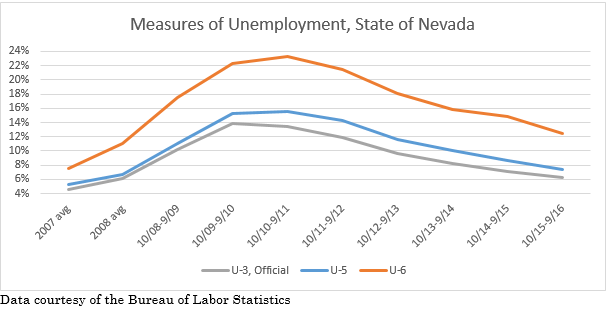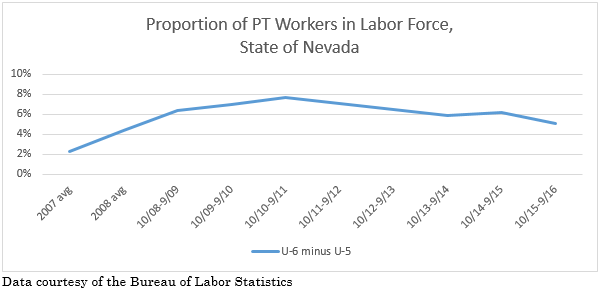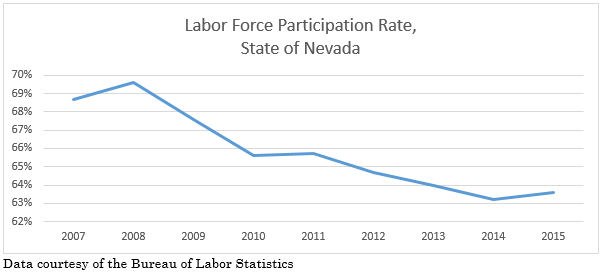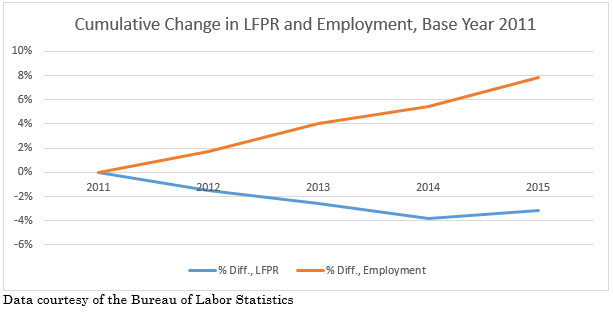Nevada’s unemployment rate normalizes to pre-recession levels
By Daniel Honchariw
Rarely does reliance on any particular statistic tell the whole story.
Thus, the fact that Nevada’s unemployment rate has returned to pre-recession levels does not necessarily indicate the state’s labor markets are as healthy as they were in December 2007, when the Great Recession hit.
Nonetheless, the news from Nevada’s Department of Employment, Training and Rehabilitation — that the unemployment rate has fallen to 5.2 percent — is encouraging, given it was nearly 14 percent as recently as 2010.
Accordingly, to achieve pre-recession levels of unemployment marks a milestone for state politicians and policy-makers who have spent the better part of the last decade trying to reverse the horrors of the worst financial crisis since the 1940’s.
Governor Sandoval, speaking to the recent employment gains, boasted:
As 2016 nears an end, I’m encouraged by the significant progress our state has made as a result of our combined efforts these past six years. . . Looking forward, I’m excited about the direction that Nevada is heading and I remain committed to working with our business community to build a stronger and more resilient economy.
Despite the indicated progress, however, all is not rosy. Other important statistics show that Nevada’s labor markets remain weaker than they were in 2007.
First, of those employed, a greater proportion are now working part-time — “part-time for economic reasons,” according to the definition used by the federal Bureau of Labor Statistics. These are workers who, despite their best efforts, have been unable to find full-time employment.
Second, continuing a decades-long trend, the relative size of the labor force as a proportion of the state’s 16-and-over population has fallen for the last 10 years — which reduces the unemployment rate as a mathematic calculation.
Together, these problematic trends suggest that — notwithstanding considerable improvement from the darkest days of the recession — the overall health of Nevada’s labor markets still lags compared to the pre-recession era.
Part-Time Employment
Today a greater proportion of employed Nevadans are part-time workers than in 2007.
Despite those workers’ inability to acquire full-time work, they are considered “employed” for purposes of measuring unemployment.
For a broader look at overall employment, the graph below tracks the “official” unemployment rate (“U-3”) as well as two alternative measures of labor underutilization: marginally-attached workers (“U-5”) and part-time workers (“U-6”).

Here the difference between the U-5 and the U-6 lines constitutes the proportion of part-time Nevadans in the labor force who, by definition, and for the purposes of the “official” unemployment rate are nonetheless considered to be employed.
From 2007 forth, the difference (U-6 minus U-5) tends to increase over time before beginning to normalize in 2011, indicating that the proportion of part-time workers has been increasing over time.

In 2007, for example, the difference between U-5 and U-6 was 2.3 percent, which indicates 2.3 percent of the labor force, or 2.4 percent of the employed labor force[1], was employed on a part-time basis.
By contrast, in 2016 the difference between U-5 and U-6 had increased to 5.1 percent (and was as high as 7.7 percent in 2011). This indicates that 5.1 percent of the labor force, or 5.4 percent of the employed labor force[2], was comprised of part-time workers.
Thus, between 2007 and 2016 part-time workers as a proportion of the employed labor force increased from about 2.4 percent to 5.4 percent. This amounts to a proportional increase of 225 percent over that period.
Given the size of Nevada’s labor force is greater than 1.4 million, approximately 70,000 people in 2016 were employed part-time because they were unable to acquire full-time employment.
In other words, if Nevada’s part-time workers were considered to be unemployed for reporting purposes, the state’s unemployment rate would be 10.3 percent — nearly doubling the “official” rate of 5.2 percent.
Labor Force Migration
Furthering this documented trend, Nevada’s labor force participation rate (“LFPR”) has decreased considerably since 2007[3].

Because unemployment measures do not account for those who are neither employed nor actively searching for work — meaning those who are not labor-force participants — by definition the employment rate increases as the LFPR decreases.
Thus, a reduction in the relative size of the labor force typically coincides with an increase in employment (or, conversely, a decrease in unemployment4).
This pattern is evident here, most notably from 2011 forward — based on improvement to the employment rate, the economy showed signs of rebounding from its lows, but such coincided with continued migration from the labor force.

Thus, the significant gains in employment since 2011 have been at least partially attributable to continued labor force migration, which has the effect of overstating progress made against unemployment.
What does this all mean?
While progress against unemployment since its 2010 highs has been encouraging, a more comprehensive analysis of Nevada’s labor markets suggests that much work is still to be done.
More specifically, it means that lawmakers should prioritize reforms which aim to increase private-sector job growth and remove employer-disincentives for hiring full-time workers.
At the federal level, all signs point to Obamacare — a law that actually encourages the hiring of part-time workers — as being first on the chopping-block for 2017.
Here’s to hoping that Nevada’s upcoming legislative session also produces similar job-creating reforms at the state level.